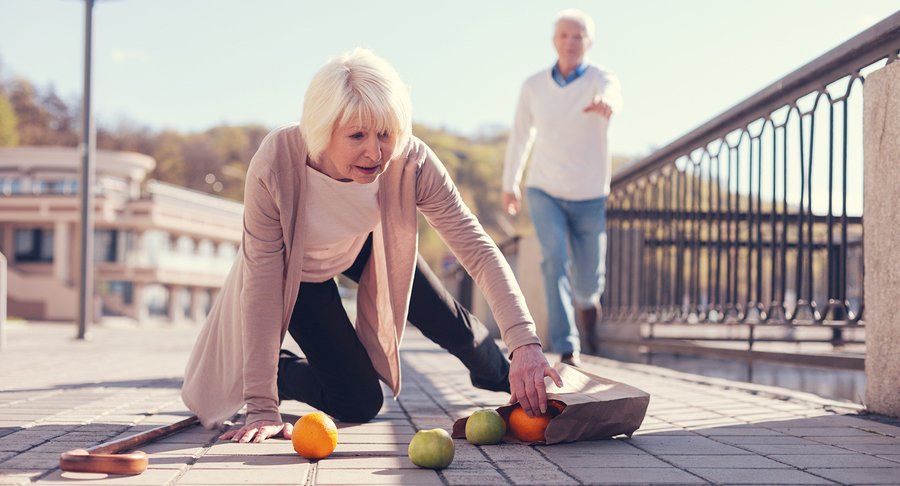Article Summary:
- Fatal elderly falls are on the rise: statistics show that 25,000 yearly US deaths are attributed to falls.
- Seniors are at greater risk when they live alone, have a chronic disease, or are on certain prescription drugs.
- Fall prevention includes balance and strength training exercises.
Falls for Seniors and Elderly on the Rise
As we age, our chance of developing many different conditions starts to rise. We try to be careful and do everything we can to avoid diabetes, high blood pressure, cardiovascular disease, cancer, and the like. But one thing we may not give thought to is the risk of falls. However, if you are a senior, falls should definitely be something to actively work to avoid. In fact, new research suggests that they can be fatal more often than you might expect.
The study, which took place at the Centers for Disease Control and Prevention in Atlanta, Georgia, found that deadly falls have risen considerably among the elderly in recent years and may contribute to 25,000 deaths annually.1Hartholt, Klaas A.; et al. “Mortality From Falls Among US Adults Aged 75 Years or Older, 2000-2016.” JAMA. 4 June 2019. Accessed 9 June 2019. http://jamanetwork.com/journals/jama/fullarticle/2735063?guestAccessKey=df56bbcc-17ca-47b0-986f-77bf6d03962e&utm_source=For_The_Media&utm_medium=referral&utm_campaign=ftm_links&utm_content=tfl&utm_term=060419. These results are based on an investigation that analyzed data collected by the CDC on adults in the United States between 2000 and 2016.
Focusing solely on men and women who were 75 and older, the assessment shows that whereas 8,600 fatal falls occurred in 2000, that had number skyrocketed to 25,190 in 2016. The research did not explore what about the falls precipitated mortality, but experience shows it could be either immediate or somewhat delayed. The death might take place right away in the case of falls that produce traumatic brain injury, or it might occur later if a hip is broken and the individual experiences a rapid decline in health afterward.
Why are Deadly Elderly Falls Becoming More Common?
There are several factors that may be at play here, putting older people at significant risk. First, there are simply more people living longer these days. What’s more, according to the Institute on Aging, a larger proportion of those over 65 are living independently, and in 2010, 11.3 million of them lived alone. This can put them at greater risk because there is no one available to help if a fall occurs and they are not able to reach a phone.
Chronic diseases are also on the rise among the elderly. For example, in 2010 nearly 21 percent of people 65 or older were diagnosed with diabetes. And while many people survive strokes, heart attacks, and cardiovascular disease for years, sometimes, health issues can leave a person in a fragile state, making them more likely to experience a fall at some point.
Another problem we face in aging is the tendency for many physicians to prescribe pharmaceutical medications for a plethora of issues that arise. These drugs can impact balance, cause drowsiness, and contribute to blurred vision, all of which can greatly raise the chance of falling over time. Also, people tend to exercise less as they age, leading to weaker leg muscles and a concomitant loss of stability. And finally, because of hormonal changes, many seniors tend to lose muscle mass as they age, especially in their thighs and hips. This takes away cushioning around hip and leg bones that have become more fragile due to bone loss—leading to more severe consequences such as broken hips when seniors do ultimately fall.
Preventing Falls as We Age
So, how do we protect ourselves and our loved ones from a potentially deadly fall in our golden years? Building both muscle strength and balance will go a long way toward preventing falls and adding to quality of life. In fact, a 2014 study at Inje University in the Republic of Korea showed that a regular routine of strength training and balance exercises at the age of 75 and over are an effective way to prevent falls in this high-risk population.2Cho, Seong-Il and An, Duk-Hyun. “Effects of a Fall Prevention Exercise Program on Muscle Strength and Balance of the Old-old Elderly.” Journal of Physical Therapy Science. 13 November 2014. Accessed 10 June 2019. http://www.ncbi.nlm.nih.gov/pmc/articles/PMC4242952/.
Muscle strengthening workouts should include body-weight exercises such as squats and modified push-ups, beginning with just a few at a time if that’s all you can do and working your way up to three sets of 10 repetitions. Balance is equally important, and a few good activities for improving your balance are tai chi, yoga, and ballet. Or simply try Jon Barron’s simple chair exercise.
Start working toward improving your strength and balance now, no matter what your age. If you’re nowhere near your 60s yet, including strength training and balance exercises in your regular routine will contribute to your overall health, keep your body lean and fit, and form habits that make it easier to stay in shape as you get older. On the other hand, if you’re already a senior, don’t think it’s too late to begin. A daily workout incorporating strength and balance will start providing you with benefits very quickly.
References
| ↑1 | Hartholt, Klaas A.; et al. “Mortality From Falls Among US Adults Aged 75 Years or Older, 2000-2016.” JAMA. 4 June 2019. Accessed 9 June 2019. http://jamanetwork.com/journals/jama/fullarticle/2735063?guestAccessKey=df56bbcc-17ca-47b0-986f-77bf6d03962e&utm_source=For_The_Media&utm_medium=referral&utm_campaign=ftm_links&utm_content=tfl&utm_term=060419. |
|---|---|
| ↑2 | Cho, Seong-Il and An, Duk-Hyun. “Effects of a Fall Prevention Exercise Program on Muscle Strength and Balance of the Old-old Elderly.” Journal of Physical Therapy Science. 13 November 2014. Accessed 10 June 2019. http://www.ncbi.nlm.nih.gov/pmc/articles/PMC4242952/. |











